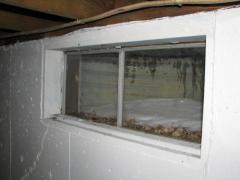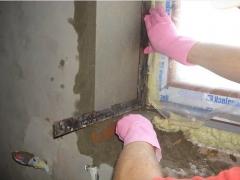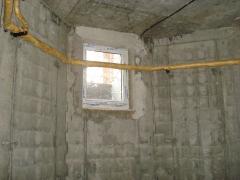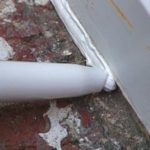The way of replacing a basement window of a private house with your own hands.
 Before answering the question how to replace a basement windows it should be notices that there are some general requirments to the process itself. Find out that each of them works before start your working. These aspects are for windows in concrete foundation, concrete block foundation, cinder blocks foundation with block and brick walls above.
Before answering the question how to replace a basement windows it should be notices that there are some general requirments to the process itself. Find out that each of them works before start your working. These aspects are for windows in concrete foundation, concrete block foundation, cinder blocks foundation with block and brick walls above.
- Old window frame, wall and weather-resistant barrier must be adequate and window frame and wall must be structurally sound.
- Window must be installed to be plumb, level and square.
- The replacement window should be approximately 1/4 less in width and height than the existing window opening once the old sash and components have been removed.
- Read all the guides you have before starting installation.
- Contact local authorities or waste management companies for proper recycling and/or disposal of removed window or patio door.
- Due to ongoing product changes, updated test results and/or new industry best practices, this installation procedure may change over time.
You will need:
- work gloves
- safety glasses
- tape measure
- 6′ level
- framer’s square
- chisel
- putty knife
- backer rod
- minimum expanding foam sealant
- interior and exterior window grade sealant
- caulk gun (How to caulk a window)
- power driver and bits
- utility knife or other cutting tool
- shims hammer
- finish nails
- appropriate fasteners
 Finishing, cleaning and maintenance rules:
Finishing, cleaning and maintenance rules:
- Do not stain or paint windows with metal frame. Product damage may occur.
- Clean glass using liquid glass cleaner.
- Clean exterior frame, sash, and insect screens using mild detergent and water with a soft cloth or brush.
- For hard to clean areas use a non-abrasive cleaner, alcohol-and-water or ammonia-and-water.
- Do not apply any type of film to insulating glass. Thermal stress and glass damage can result. Shading devices (insulated coverings, shutters, etc.) may also cause thermal stress damage.
Step 1 – Inspecting new window and verify opening
Inspect for proper size and condition and verify that all parts are included. Inspect existing wall and rough opening for structural decay. Repair as needed.
Step 2 – Clearing the opening of any debris
Remove all material that may interfere with installation process. Check sill plate for level. Sill must be level. Shim sill plate if necessary. Check opening for plumb and level. If opening is not plumb or level, correct as necessary. Check opening for square by measuring diagonally, upper left to lower right and upper right to lower left corner. Measurements must be within 1/8″. If opening is not square, correct as necessary. Inspect opening for correct size. Opening should be 1/2″ larger than window size in width and height.
Attention! Sliding window shown for illustration purposes. These instructions also cover hopper windows.
Recommend: How to measure windows for replacement.
Step 3 – Adding wood frame if necessary
 If it’s necessary, construct a frame using preservative treated wood of the appropriate depth for your opening (typically 2 x 6 or 2 x 8). Secure the frame to the opening using appropriate fasteners (masonry screws, anchors, etc.). Recheck for plumb, level and square.
If it’s necessary, construct a frame using preservative treated wood of the appropriate depth for your opening (typically 2 x 6 or 2 x 8). Secure the frame to the opening using appropriate fasteners (masonry screws, anchors, etc.). Recheck for plumb, level and square.
Step 4 – Checking fit of window
Temporarily place the window in the frame tilting in from the bottom and check for fit. Then remove window. Adjust opening as needed.
Step 5 – Adding a “blind stop”
Create a “blind stop” for the window, using a 3/4″ quarterround or comparable piece of wood around the top and sides of the wood frame. Make sure the inside of the “blind stop” is at least 4″ from the inside of the wood frame, leaving enough room to install the window and interior trim. Recheck for plumb, level and square. Use finish nails to secure the “blind stop”.
Step 6 – Drilling installation holes
If installing a window that does not have pre-drilled installation holes, open sash. Drill the installation holes according to the fastening instructions from local building code. Countersink holes so top of fastener does not interfere with window operation.
Step 7 – Applying sealant to opening
Apply sealant to inside edge of blind stops where window will contact them. Also apply sealant to bottom of wood frame where window will contact frame. NOTE: If blind stop is not used, apply backer rod and sealant between window and frame.
Step 8 – Placing the window into opening and shim
 Place window into opening, tilting in from bottom, and seat securely against blind stops. Make sure weep holes are on the bottom and facing outside, if applicable. Lock and/or handle should be on the interior. Shim behind each installation hole in the frame. Check for plumb, level and square as needed.
Place window into opening, tilting in from bottom, and seat securely against blind stops. Make sure weep holes are on the bottom and facing outside, if applicable. Lock and/or handle should be on the interior. Shim behind each installation hole in the frame. Check for plumb, level and square as needed.
Step 9 – Fastening your new window
Open each sash and drill 1/8″ pilot holes through pre-drilled holes. Fasten window to frame using supplied installation screws if applicable, or appropriate fasteners. Do not over tighten screws.
We hope this article helped you in case you were searching an answer to the question how to replace basement windows.
Q&A
Question: I want to change the windows in my basement. What material should I choose to make them last?
Answer: In the basement floor install window structures with plastic, wood and aluminum profiles. But we do not recommend installing either wooden or aluminum windows.
Plastic basement windows are the most popular because of their practicality, durability and ability to increase the light opening by about 10% without loss of rigidity and thermal qualities. Professionals recommend installing PVC constructions in semi-basement rooms. The window must have sashes that can be opened, as basement rooms require systematic ventilation to avoid the formation of condensation on the walls. In those places where the plastic profile in contact with the walls of the basement, requires a waterproofing and thermal insulation layer.
Question: The basement of my house often flooded through the old window after heavy rains. How can I avoid this when installing a new window?
A very important point when installing a window in the basement is to protect the room from possible flooding. For this purpose, special pits are created. Such an element is mandatory when the window aperture is located underground. Parameters of the pit directly depend on the size of the window opening. For example, if the PVC window is almost completely buried under the ground, the bottom of the pit should be near the bottom of the window. Pit should be deeper than the bottom of the window construction for about 8 in.
Drainage is mandatory:
- If the house stands on the ground with high water permeability, it is recommended to install a perforated pipe, diverting water to a depth of 1 m. To particles of soil do not clog perforation, it is filled with fine crushed stone or gravel;
- If the ground on which the house is located poorly absorbs water, around the foundation organize a circular drainage system. A ditch is dug along the perimeter, drainage pipes are laid and wells are installed.
Question: If the house is already built and there is no basement window in it. But I want to equip the basement with a window. Is that possible?
If the house has already been built and there is no window for the basement, it is still possible to install it. You need to take into account where the room is located: partially above ground or completely underground. In the semi-basement windows are installed without problems. More difficult situation with basements, located entirely underground. To glaze such a basement you need to partially dig out the wall, arrange the pit and only then install the window opening.
First of all, you need to design the structure and mount the window lintel. Then, in the basement wall is knocked out a hole (opening), mounted the profile, installed window sills, slopes. Install windows is not easy enough, since the creation of a new window will inevitably damage the thermal and waterproofing layers of the structure. It means that the surface will have to be insulated again, and the installation joint where the window profile is in direct contact with the walls will have to be worked on very carefully.
The ideal solution for glazing the basement will be PVC windows with anti-burglary hardware and a profile with a closed reinforcement. In a modern basement room should install a window with a heavy-duty triplex glass, resistant to high mechanical stress.
Do not forget about the installation of protective visor, such as polycarbonate. Such a design will prevent precipitation and direct sunlight from entering the basement.



